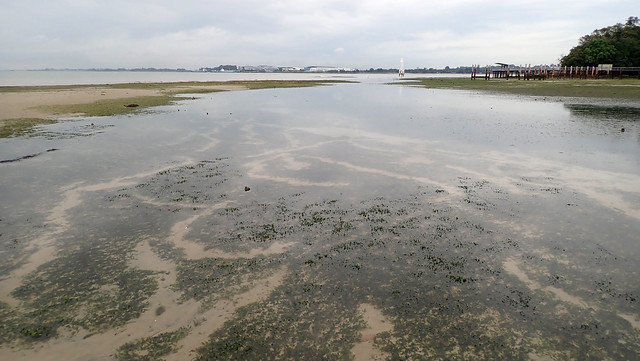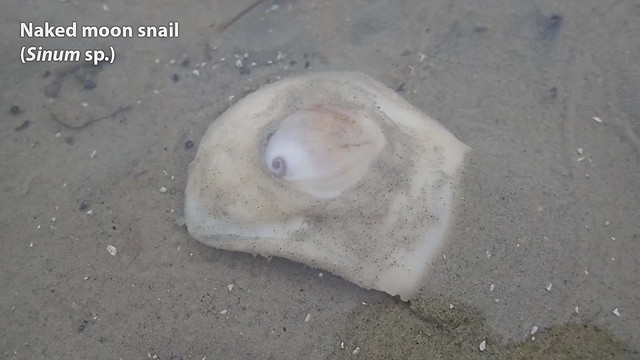It was great to see lots of dugong feeding trails near the southern sand bar! As well as many other interesting marine life! Thanks to NParks for permission to do this survey of Chek Jawa.
This is the time of the year that we survey the northern sand bar at Chek Jawa. The sand bar remains wide and long, and there is seagrass on the seaward side too. Unlike our last trip here in Jan 2019, I didn't come across many dugong feeding trails on the northern sand bar, just one or two.But there were lots of feeding trails near the southern sand bar near the boardwalk!
The seagrass meadows remained lush. Mostly Spoon seagrass and Needle seagrass (with narrow leaf blades), I didn't come across much Fern seagrass. This is similar to our annual survey here in Jan 2019 and Nov 2017. I didn't see the large patch of Smooth ribbon seagrass at the inner edge of the northern sand bar that I saw on Jan 2019. But Smooth ribbon seagrass continues to be lush near the boardwalk at the southern sand bar.
It was a relief to see many healthy Haddon's carpet anemones in the middle of the lagoon. Although some of these anemones near the southern sand bar were rather 'crunched up', none of the anemones were bleaching. There were also many Swimming anemones and many cerianthids, all looking normal. During the 2007 mass death, the prolonged exposure to freshwater caused the carpet anemones to balloon up and then burst.
Alas, I came across fragments of an Eight-armed sea star, a small pale sea star (a Knobbly sea star?) that looked like it was dying, and a White sea urchin that looked unwell. During the 2007 mass death, all the Common sea stars (which used to be abundant on Chek Jawa) melted away and have not returned since.
Juria and Adrianne also came across some Biscuit sea stars that didn't look well or were dying. At the same time, we also saw healthy happy versions of these same kinds of sea stars as well as Sand stars. So not all the sea stars were melting.
Adrianne shared this dismembered arm of a sea star, probably the Eight-armed sea star.
There were lots of Cake sand dollars on the northern sand bar. I saw many medium sized Garlic bread sea cucumbers that looked healthy. I also saw many small Pink warty sea cucumbers, some Ball sea cucumbers, while the rest of the team saw Thorny sea cucumbers too. During the 2007 mass death, many Garlic sea cucumbers lay on the surface dead and dying.
Juria saw a Grey bonnet snail, which is to be expected, as we have seen these snails feeding on sand dollars at Cyrene Reef.
Closer to the boardwalk, I saw many Fan clam shells and Window pane clams. Fortunately, we did not come across any of the clams that had taken over Changi beach recently. But there were a lot of Tiger moon snails on the northern sand bar, and an unusually large number of Margined conch snails on the southern sand bar.
I only saw one live Button snail! I also came across one large Naked moon snail and a Black tailed slug. Here's a video compilation of these molluscs.
I saw their pink beehoon-like egg strings first, then later on a Spotted sea hare.
This pretty nudibranch was also seen on the boardwalk legs.
It was a relief to see healthy sponges on the boardwalk legs. During the 2007 mass death, the sponges on Chek Jawa melted and didn't return for many years.
Other interesting sightings include Vincent's sighting of this snake eel, which I haven't figured out the ID for.
Juria saw this Spearer mantis shrimp that appears to be coated with slime. Not really sure what is going on.
There were lots of migratory shorebirds feeding as well as some Great billed herons. A wild boar also ambled along the shore. We kept our distance from them to avoid disturbing them. Here's a photo of some of them by Jonathan.
During the trip, Joleen Chan made this unique observation which she submitted to Singapore Biodiversity Records at the Lee Kong Chian Natural History Museum. Here's her report.
The floating pontoon portion of the boardwalk has been removed for maintenance and will be placed back eventually. Until they are place in place, NPark's public intertidal walks are suspended.
As usual, there were lots of large trash on the northern edge of Chek Jawa near the security fence. Much of the trash look like they come from the nearby fish farms.
Unfortunately, the team came across a small abandoned crab trap which had a filefish and some other small animals in it. The animals were released and the trap removed from the shore.
What is the fate of Chek Jawa?
Chek Jawa and Pulau Sekudu may be affected by the 2030 landuse plan by the Ministry of National Development. The plan includes plans for a road link (black line) from the mainland jumping off at Punggol, crossing to Pulau Ubin through Chek Jawa to jump off to Pulau Tekong before circling back to the mainland on Changi East. Proposed reclamation (in yellow) will bury Pasir Ris shores, Pulau Sekudu and Chek Jawa as well as a large amount of shore at Changi Beach. I feel it is thus important to update our understanding of what is going on in the field at these sites including Chek Jawa and Pulau Sekudu.
 |
| click on images for larger view. |
Among the Proposed Areas for Immediate Conservation Priority, the Singapore Blue Plan 2018 proposes that the intertidal and subtidal marine areas of Pulau Ubin to be designated Marine Reserve.
The proposed area would include Tanjung Chek Jawa, the largest known intertidal area in northern Singapore. Considered one of the richest in Singapore, Chek Jawa comprises many adjacent ecosystems: coastal hill forest, mangrove areas, rocky shores, seagrass meadows, coral communities, and sandy areas. Chek Jawa remains an icon of celebration and hope for many Singaporeans since its reprieve from reclamation in 2001.
Much of the remaining coastal areas around Pulau Ubin are mangrove areas. Protecting these can be impactful due to the relatively large interconnected areas. Already, a community-driven project, Restore Ubin Mangroves (R.U.M.) Initiative, is in place to rehabilitate mangrove areas previously converted to fish and shrimp farms. These areas also offer hope for the recovery of the smallclawed otter population.
DOWNLOAD the Plan, SUPPORT the Plan! More on the Singapore Blue Plan 2018 site.
Photos by others on this trip
Adrianne Lee
Liz Lim
Juria Toramae
Kelvin Yong
Jonathan Tan
Loh Kok Sheng
Frances Loke on Little Green Men
Joleene Chan
Vincent Choo














